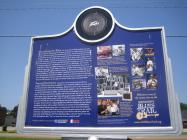Inscription
Front
The electronic amplification of vocals and musical instruments resulted in dramatic changes in the blues in the post-World War II era, notably the rise to prominence of the electric guitar. Peavey Electronics, founded in 1965 by Meridian native Hartley Peavey, contributed to the sound of modern electric blues, rock, country, and jazz through its amplifiers, sound systems, and electric guitars and basses. The company also achieved worldwide renown for its many technological innovations.
Rear
Electrifying the Blues The arrival of electronically amplified instruments was one of the most striking changes in the history of the blues, as it allowed musicians to be heard by larger crowds and to change the aural quality of their music. For the first decades of the blues musicians had to rely on the sounds of their acoustic instruments and the power of their voices, but this began to change in the 1930s with the arrival of the electric guitar and the widespread use of electronic microphones. Musicians in the Hawaiian and Western Swing styles pioneered the use of the electric guitar, and the first blues recordings featuring the instrument were made in 1938, when George Barnes appeared on a Big Bill Broonzy session and Casey Bill Weldon—the "Hawaiian Guitar Wizard"—played an amplified steel guitar on two songs. Among the first blues artists to amplify their guitars were T-Bone Walker in California, Memphis Minnie, Broonzy, and Tampa Red in Chicago, and Robert Nighthawk, Robert Lockwood, Jr., Elmore James, Joe Willie Wilkins, and Houston Stackhouse in Mississippi and Arkansas. Amplification became the standard after World War II with the arrival of widespread availability of electricity to rural areas such as the Mississippi Delta and mass-produced electronic instruments. After electric bass was introduced in 1951, one of the first users of the instrument in Mississippi was Herman Fowlkes, father of Cassandra Wilson.
Peavey Electronics Instruments were just one part of the electrification equation—to be heard, they had to be amplified. It was in the field of amplifiers and sound systems that Peavey Electronics made its first contributions. Hartley Peavey, born in 1941, converted his acoustic guitar into an electric instrument and built his first amplifier in 1957 after being inspired at a concert by Mississippian Bo Diddley, who was also known for building his own guitars and amps. In 1961 Peavey created his first amplifier under the Peavey brand, and in 1964 was issued his first patent. Peavey Electronics began hand-producing guitar and bass amplifiers in 1965 and moved into PA (public address) systems in 1968. In 1977 Peavey began producing the T-60 model guitar and T-40 model bass, and by the following year was one of the largest producers of guitars in the country. Peavey innovative, computer-guided mass production techniques were soon adopted throughout the industry, and the company continued as an innovator in areas including microphones, keyboards, audio processing, drums, and sound consoles. Peavey sound systems gained prominence at many of the world's leading venues, while Peavey guitar amps became the amplifier of choice for many performing musicians. Mississippi artists who have used Peavey guitars and amps include Luther Dickinson of the North Mississippi Allstars, who said, "Peavey is the sound of the Mississippi juke joint. That's our sound and we take it around the world."
Details
| HM Number | HM1GOC |
|---|---|
| Series | This marker is part of the Mississippi Blues Trail series |
| Tags | |
| Marker Number | 169 |
| Year Placed | 2013 |
| Placed By | The Mississippi Blues Commission |
| Marker Condition | No reports yet |
| Date Added | Saturday, October 4th, 2014 at 5:55am PDT -07:00 |
Pictures
Locationbig map
| UTM (WGS84 Datum) | 16S E 340162 N 3587406 |
|---|---|
| Decimal Degrees | 32.41228333, -88.69975000 |
| Degrees and Decimal Minutes | N 32° 24.737', W 88° 41.985' |
| Degrees, Minutes and Seconds | 32° 24' 44.22" N, 88° 41' 59.1" W |
| Driving Directions | Google Maps |
| Area Code(s) | 601 |
| Which side of the road? | Marker is on the right when traveling North |
| Closest Postal Address | At or near 5000-5498 MS-493, Meridian MS 39305, US |
| Alternative Maps | Google Maps, MapQuest, Bing Maps, Yahoo Maps, MSR Maps, OpenCycleMap, MyTopo Maps, OpenStreetMap |
Is this marker missing? Are the coordinates wrong? Do you have additional information that you would like to share with us? If so, check in.
Nearby Markersshow on map
Show me all markers in: Meridian, MS | Lauderdale County | 39305 | Mississippi | United States of America
Site of Meridian Male College
Site of Meridian College and Conservatory
Gillespie V. "Sonny" Montgomery
Gillespie V. "Sonny" Montgomery
Poplar Springs Road Historic District
Dr. Jeff Anderson House
10th Avenue Masonic Cemeteries
St. John Baptist Church
St. Joseph Catholic Church
Lewis Edmund "Buck" Crook, Jr.
Maintenance Issues
- What historical period does the marker represent?
- What historical place does the marker represent?
- What type of marker is it?
- What class is the marker?
- What style is the marker?
- This marker could use another picture or two.
- Can this marker be seen from the road?
- Is the marker in the median?


Comments 0 comments